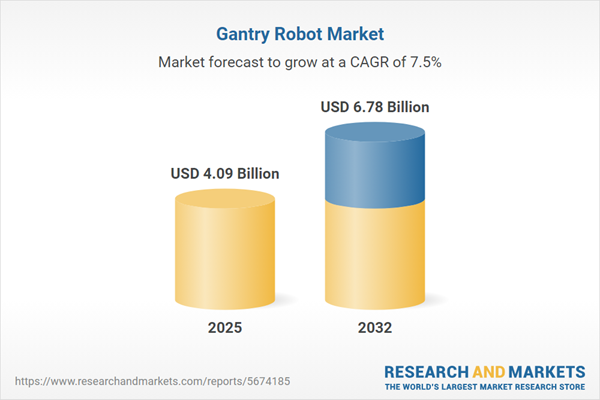Speak directly to the analyst to clarify any post sales queries you may have.
Gantry robot technology is rapidly reshaping industrial automation strategies, empowering senior decision-makers to build greater adaptability and consistency into manufacturing and logistics operations. In an era defined by fast-shifting demands and stringent performance standards, these systems serve as crucial enablers for organizations prioritizing scalable, future-ready process optimization.
Market Snapshot: Gantry Robot Market Growth & Trajectory
The global gantry robot market is experiencing robust expansion, valued at USD 3.81 billion in 2024 with a projected rise to USD 4.09 billion in 2025 and USD 6.78 billion by 2032, underpinned by a 7.47% compound annual growth rate. This growth is driven by broad-based modernization across sectors, heightened need for precise automation, and accelerated Industry 4.0 adoption. Organizations in both established and evolving industries are expanding gantry robot investments to facilitate digital transformation, streamline operations, and build agility into their workflows. These trends reflect the central role gantry robot automation plays in responding effectively to production shifts and market disruptions.
Scope & Segmentation: Gantry Robot Market Overview
- Applications: Automated assembly, material handling, painting, pick and place, welding, and packaging support diverse industry needs—enabling workflow modernization and compliance uplift in sectors such as automotive, electronics, pharmaceuticals, and food processing.
- End-User Industries: Automotive, electric vehicle, semiconductor, medical device, chemical, pharmaceutical, and food and beverage organizations leverage gantry robots to resolve bottlenecks, raise efficiency standards, and reinforce hygiene and quality controls.
- Types of Gantry Robots: Single-axis, two-axis, and five-axis systems address a wide spectrum of operational demands, from routine manufacturing to specialized or bespoke production runs.
- Drive Systems: Ball screw, belt drive, and rack and pinion technologies are deployed to balance speed with accuracy and maintenance needs, aligning automation selection with required uptime and output levels.
- Payload Capacities: Solutions range from lightweight variants for detailed assembly to robust options geared for handling substantial materials, meeting the varied demands of modern production.
- Deployment Modes: Gantry robots are available as stationary systems or as integrated modules on mobile platforms such as Automated Guided Vehicles, providing scalable automation suited to fixed and adaptable facility layouts.
- Regional Segmentation: Adoption intensity is influenced by industrial growth rates, regulatory settings, and supplier ecosystem maturity across the Americas, Europe, Middle East, Africa, and Asia-Pacific. Local market conditions and evolving standards play a critical role in shaping demand patterns.
- Leading Companies: Key suppliers—including Fanuc, Yaskawa Electric, ABB, KUKA, Mitsubishi Electric, Kawasaki Heavy Industries, DENSO, Toshiba Machine, Siemens, and Parker-Hannifin—continue to advance technology and deepen market adoption through innovation.
Key Takeaways: Strategic Insights for Senior Decision-Makers
- Standardized gantry robot solutions help organizations sustain compliance as regulations evolve, supporting multi-market deployments without major reconfiguration.
- Integration of adaptive sensors and smart controls supports predictive maintenance strategies, promoting maximized uptime and reduced process interruptions.
- The use of artificial intelligence within gantry workflows facilitates rapid production changeovers and responsiveness to updated process specifications or external supply disruptions.
- Adopting energy-efficient and recyclable gantry systems enhances alignment with sustainability and cost-control imperatives across supply networks.
- Collaboration with automation providers enables organizations to reduce transition risk and speed technology implementation during periods of market or compliance change.
- Advanced inspection capabilities integrated into gantry-based workflows boost output quality and reliability, even in complex and variable production environments.
Tariff Impact: Navigating US Trade Policy Shifts
Recent US tariff adjustments on gantry robot imports are causing companies to reassess supplier selection and sourcing approaches. Favoring domestic or nearshore partnerships can increase continuity and flexibility as trade and compliance conditions evolve. Modular automation systems further support streamlined compliance, safeguarding investments in changing environments. Effective supplier engagement is now a pivotal aspect of risk management and operational agility.
Methodology & Data Sources
This analysis draws on structured interviews with subject-matter experts, direct assessment of advanced manufacturing deployments, and comprehensive technical literature reviews. Approaches including triangulation, SWOT analysis, and Porter’s Five Forces model help ensure analytical rigor and reliability.
Why This Report Matters
- Senior decision-makers receive frameworks and action steps for building resilient gantry robot automation into core operations.
- Segmentation insights help anticipate shifts in compliance and supply chains, supporting future-proof investment planning and strategic allocation of resources.
- Actionable guidance supports integration of adaptable solutions tailored for dynamic production environments and scalable business needs.
Conclusion
Gantry robot automation and forward-looking sourcing strategies provide organizations with the tools to sustain agile, resilient operations. The insights in this report support effective automation management amid increasing industry complexity.
Additional Product Information:
- Purchase of this report includes 1 year online access with quarterly updates.
- This report can be updated on request. Please contact our Customer Experience team using the Ask a Question widget on our website.
Table of Contents
3. Executive Summary
4. Market Overview
7. Cumulative Impact of Artificial Intelligence 2025
Companies Mentioned
The companies profiled in this Gantry Robot market report include:- Fanuc Corporation
- Yaskawa Electric Corporation
- ABB Ltd.
- KUKA AG
- Mitsubishi Electric Corporation
- Kawasaki Heavy Industries, Ltd.
- DENSO Corporation
- Toshiba Machine Co., Ltd.
- Siemens Aktiengesellschaft
- Parker-Hannifin Corporation
Table Information
| Report Attribute | Details |
|---|---|
| No. of Pages | 196 |
| Published | November 2025 |
| Forecast Period | 2025 - 2032 |
| Estimated Market Value ( USD | $ 4.09 Billion |
| Forecasted Market Value ( USD | $ 6.78 Billion |
| Compound Annual Growth Rate | 7.4% |
| Regions Covered | Global |
| No. of Companies Mentioned | 11 |









